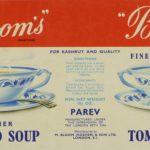Bloom’s Soup Label
- What can we see?
We can see the label of a canned tomato soup with the company’s name and logo, “Bloom’s”, written on top. The soup is called “Bloom’s finest kosher tomato soup”. The label also shows directions on how to cook and serve the soup, its ingredients and a picture of the soup being served.
Look closely, what can you see?
- What do we know?
Bloom’s was a famous kosher restaurant in north London. In 1920 the original restaurant at No.58 Brick Lane in Stepney was established by Morris Bloom, who was a Lithuanian immigrant who arrived in London in 1912. He was a connoisseur of table delicacies and developed the original Vienna-style veal as well as a new and tastier method of pickling salt beef and his idea was a huge success. Soon enough, Bloom’s became so successful that the Bloom’s salt beef sandwich became a household name.
In 1930 Bloom’s opened a Kosher Food Factory at 111 Wentworth Street, Stepney and in 1952, shortly after Morris Bloom passed away, the restaurant moved to 90 Whitechapel High Street. Sidney Bloom, Morris’ son, opened a department which produced canned foods to deliver food to people’s houses, Jewish schools or even kosher holiday camps. Sidney opened a restaurant in 130 Golders Green Road, which served traditional Ashkenazi-style Jewish cuisine.
In 2007, a new restaurant was opened in Edgware, but soon closed, followed by the restaurant in Golders Green in summer 2010. It was the famous food and also the famous rudeness of the staff that kept people coming. The waiters had to pay for each meal they served from the kitchen until they earned commission on what they sold. But the food was so good that the rudeness was tolerated. Bloom’s had a wide variety of traditional kosher meals from salt beef, chicken soup, kneidlach and pickled cucumber to lokshen.
- What do we wonder?
We might wonder why Bloom’s chose such a system of payment. We might also wonder if people visited Bloom’s because it reminded them of “home”.
What do you wonder?
- Object File
Object Name: Food label
Date: 20th century
Catalogue number: 2000.45.20
Size (cm): 2,48 x 1,05
Created by: M Bloom (Kosher) & Son Ltd
Between 1880 and 1914 Jewish people in Eastern Europe faced a lot of persecution, economic hardship and therefore extreme poverty. About 150,000 Jewish people came to England to flee from these poor living conditions and many settled in the East End of London. At that time Jews were not completely accepted in England’s society. Prejudice led to discrimination and some groups started forming their own communities in order to maintain their culture. For example, Yiddish was widely used as a language in theatre and press in the East End. Small synagogues were built, kosher shops and butchers opened and so did restaurants. A big part of Jewish culture is food, which is the reason why the opening of Bloom’s caused such an immediate success. Bloom’s was symbolic for the Jewish East End. It was a community centre – the home of Jewish orthodox cooking and a meeting place to discuss family history. Whitechapel’s Jewish population started to decline as Jewish people became more integrated in London’s wider society. Although the restaurants closed down, the legacy can still be seen in the East End.



